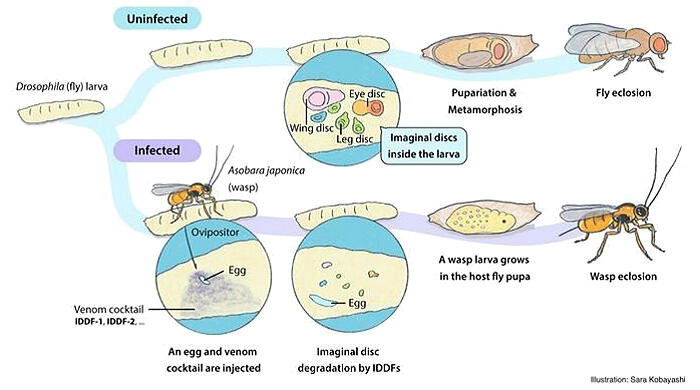Parasitoid wasps lay eggs in other insects and spiders, using them as hosts. Among these, some wasp larvae grow by extracting nutrients from their hosts while growing alongside them. When the host turns into a pupa, the wasp eats the host and ecloses. The key to this "koinobiont parasitism" strategy is the "venoms" that are injected into hosts during oviposition.
A research team led by Associate Professor Yuko Shimada of the Life Science Center for Survival Dynamics at the University of Tsukuba discovered that the wasp venoms selectively degrade only the "imaginal discs" necessary for host flies to develop into adults. They named this phenomenon "imaginal disc degradation (IDD)." Meanwhile, there were no changes in the organs necessary for host fly behavior and development. This suggests that the wasp venoms selectively kill only the imaginal discs that are unnecessary for the wasps.
To identify the venom components that induce cell death in the host fly's imaginal discs, the researchers decoded the entire genome sequence of the parasitoid wasp and identified 63 candidate IDD-related venom genes. To investigate their functions, they developed a method to suppress the function of specific genes and created wasps with individual target genes rendered non-functional. Experiments with these wasps revealed that when either of two specific venom genes lost its function, cell death was not triggered. Furthermore, this suppression of cell death significantly inhibited IDD, revealing that these two venom genes are essential for IDD induction.
These findings have identified parasitoid wasp venom genes and revealed part of the molecular mechanism of koinobiont parasitism, while also showing the potential for parasitoid wasp venom to become a new research subject in biological toxins. In the future, they have the potential to be utilized as seeds for pesticides and natural medicinal resources by investigating the mechanism of action of parasitoid wasp venoms targeting various insects.
Life cycle of host flies with and without wasp parasitism





